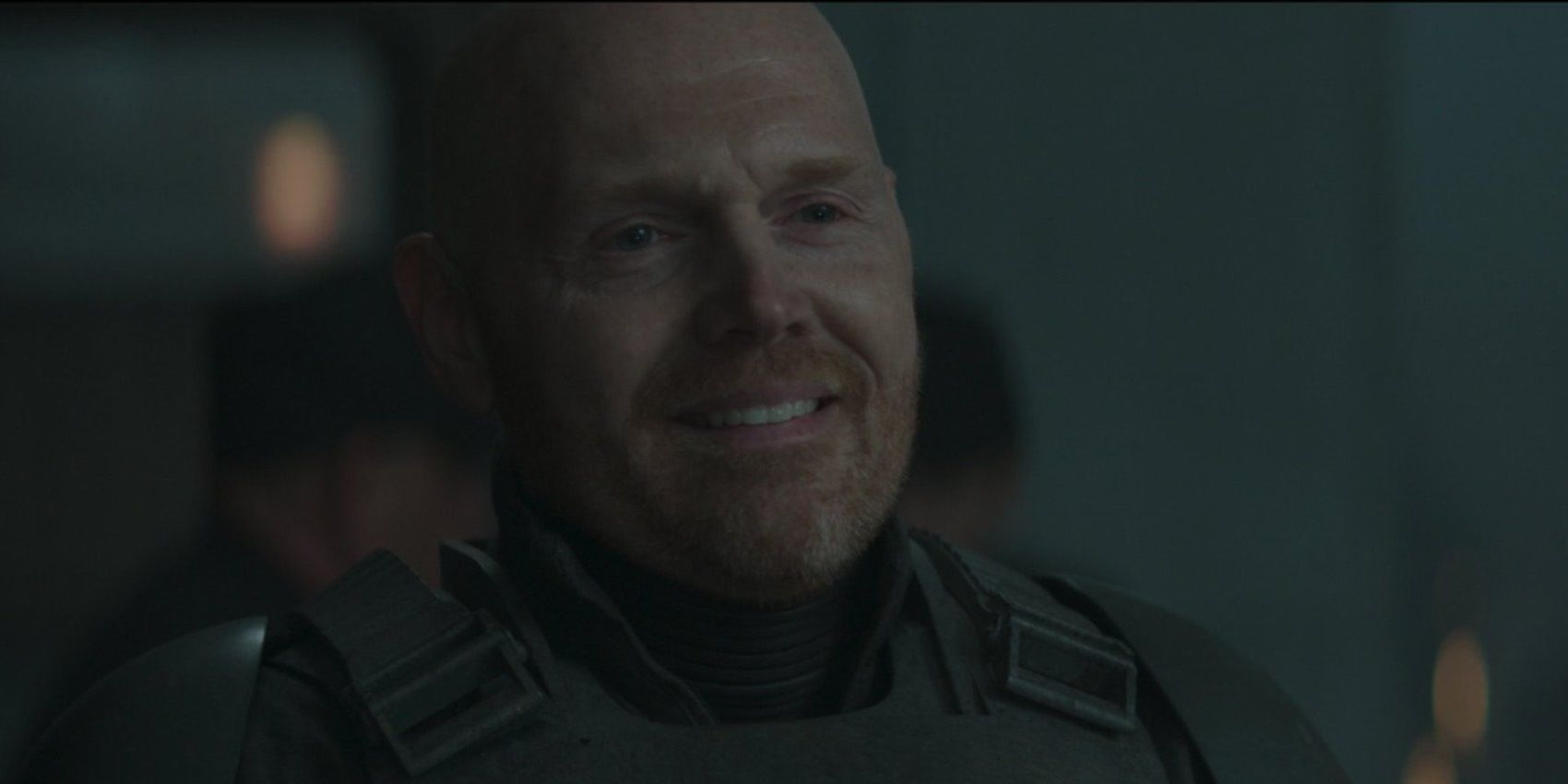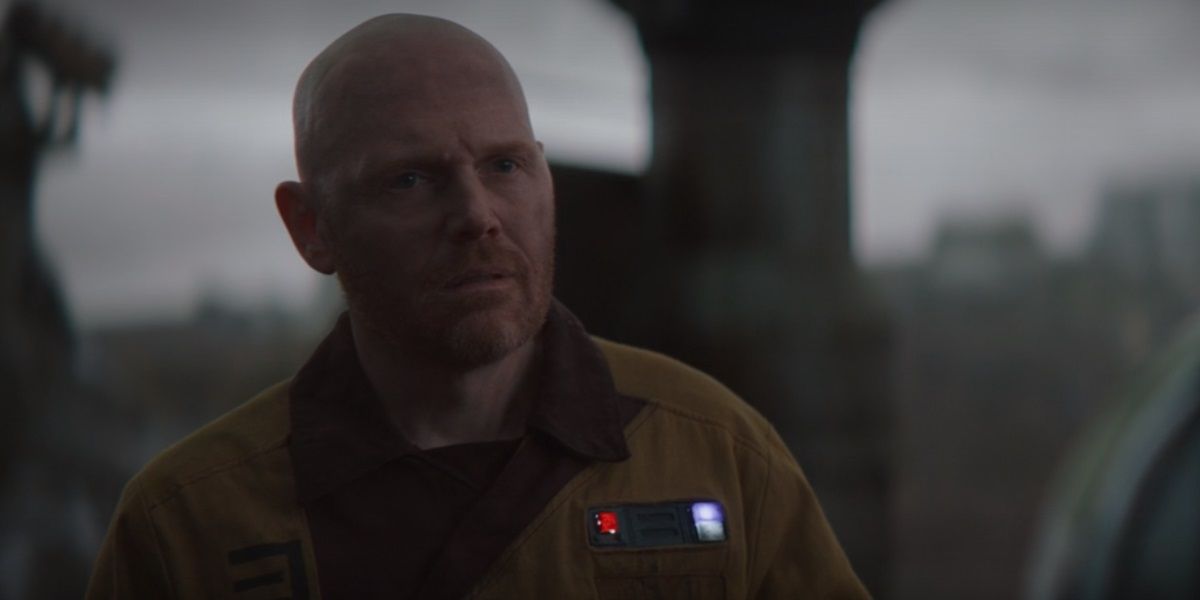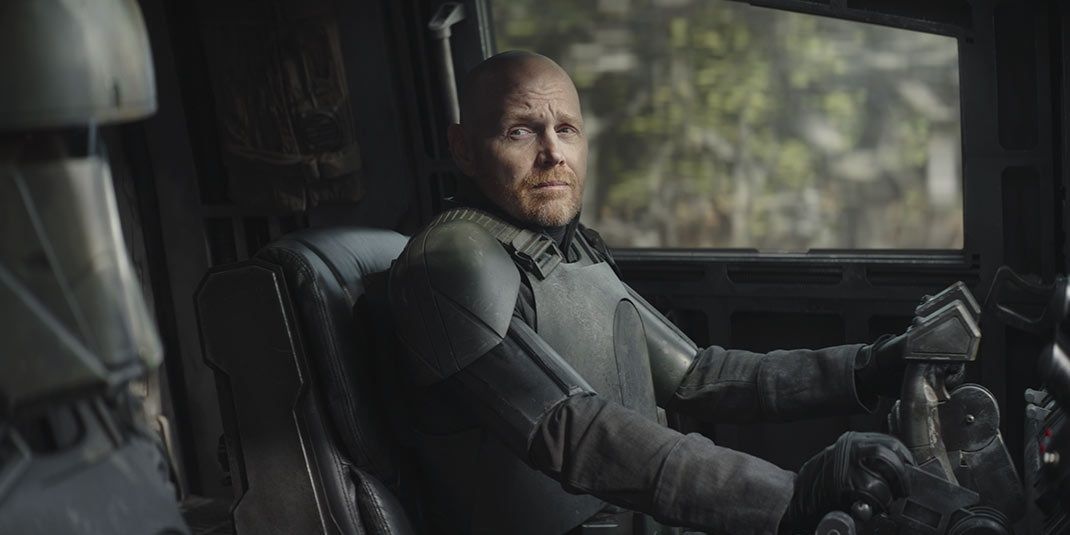
When Bill Burr was cast in a guest role in the first season of The Mandalorian, some fans thought it might be stunt casting in response to the comic’s famous rants about Star Wars. His character Migs Mayfeld was introduced as a brash, wisecracking hard-ass in line with Burr’s comedic persona in his introduction in season 1’s “Chapter 6: The Prisoner,” in which he was on a crew that hired Mando to spring an inmate from a New Republic prison and then double-crossed him at the last second. “The Prisoner” was a great adventure-of-the-week episode and Burr’s performance was a big part of what made it so fun, but it didn’t seem like the character would ever develop beyond his acid-tongued persona.
However, Mayfeld’s second appearance on The Mandalorian – in season 2’s “Chapter 15: The Believer” – added all kinds of depth to the character, revealing the remorse he feels for his time with the Empire and the PTSD he’s left with after the Galactic Civil War. “The Prisoner” and “The Believer” were both masterfully helmed by Dope director Rick Famuyiwa, who will hopefully continue to guide Mayfeld’s character arc through the Mando-verse.
RELATED: Boba Fett's Return To Action In The Mandalorian Was Worth The 40-Year Wait
Serving a prison sentence following the events of “The Prisoner,” Mayfeld is released into Cara Dune’s custody so he can help with the search for Grogu. Moff Gideon has captured the kid and to determine the location of his cruiser, Mando needs to infiltrate an Imperial Remnants base and access their computers. As an ex-Imperial marksman, Mayfeld has the clearance codes he’ll need to get into the base and access the Moff's coordinates.

Like most comedians who have crossed over into acting, Burr tends to be self-deprecating when discussing his acting abilities. He’s clearly more comfortable on the standup stage than in a galaxy far, far away, but he’s a much better actor than he gives himself credit for. In “The Believer,” Burr chipped away the cocky facade that he built around Mayfeld in “The Prisoner” and revealed glimpses of the vulnerable human being underneath. And, much like Harrison Ford, Burr’s real-life indifference to the Star Wars phenomenon has resulted in authentic on-screen coolness that fans of the saga can’t fake.
While Mayfeld’s constant wisecracking was appreciated and encouraged by Ran’s band of degenerates in “The Prisoner,” it’s ignored by Mando’s stern-faced crew of professionals in “The Believer.” Since he can’t joke his way through every situation, he opens up more. He tells Mando, “As far as I’m concerned, if you can make it through the day and still sleep at night, you’re doing better than most.” This line reveals a lot of psychological torment. Months of doing hard labor and being trapped in a prison cell for most of the day have left Mayfeld alone with his thoughts, reflecting on his experiences with the Empire, and it’s shown to have seriously affected his psyche.
In addition to deepening his own character, Mayfeld brought some new angles to The Mandalorian’s themes in season 2. On the drive to the Imperial base, he pokes holes in Mando’s creeds. After Mando changes into a Stormtrooper uniform for the infiltration, Mayfeld wonders if the Way of the Mandalore forbids him from removing his helmet or showing his face. They’re essentially the same thing if a helmet is part of someone’s everyday attire, but there is a difference, as Mayfeld points out. Mando’s silence in the face of Mayfeld’s riffing suggests he’s reluctantly questioning his beliefs; Mayfeld makes a few good points. Recognizing that Mando is disregarding a lot of his creeds because saving Grogu means more to him than sticking to them, Mayfeld says, “Your rules start to change when you get desperate.” Later in the episode, Mando actually shows his face to a whole room full of Stormtroopers so he can scan it to get the coordinates of Moff Gideon’s location so he can rescue the kid.
As they drive through the war-ravaged streets of Morak, Mayfeld tells Mando, “Empire, New Republic, it’s all the same to these people.” The villagers desperately recovering from years of death and destruction recognize the Star Wars saga’s “good guys” and “bad guys” as one and the same: “invaders on their land.” Interestingly, the pirate attack on Mando and Mayfeld’s rhydonium rig gets the audience to cheer for Stormtroopers and TIE fighters as they approach the bridge to the refinery with dwindling hope and Imperial forces triumphantly come to the rescue. In the spirit of The Mandalorian’s ongoing revisionist western-like deconstruction of Star Wars’ myth-making, “The Believer” posits that there is no such thing as the “good guys” and the “bad guys.”

The sun-drenched, war-torn jungles of Morak evoke the Vietnam War. A lot of Vietnam-era stories focused on soldiers’ PTSD – Apocalypse Now, Taxi Driver, The Deer Hunter etc. – and Mayfeld’s PTSD becomes a major player in the episode’s tense second-act standoff. At the refinery, Mando and Mayfeld get roped into having a drink with the latter’s former commanding officer, Valin Hess, played with brilliant Cushing-like smarm by Richard Brake. Mayfeld estimates that between 5,000 and 10,000 civilians and fellow troops lost their lives in Operation Cinder due to Hess’ callous decision-making. Freedom fighters died defending their homes. Hess doesn’t show an ounce of guilt, simply declaring the fallen soldiers to be “heroes of the Empire” and disregarding all the other casualties. In advocating the Empire’s authoritarian system of government, Hess reasons, “Everybody thinks they want freedom, but what they really want is order.”
Recalling Operation Cinder and seeing Hess’ complete lack of remorse for the blood on his hands reminded Mayfeld that the Empire is truly evil. He makes the snap decision to shoot Hess dead, then immediately learns that violence begets more violence as he and Mando have to shoot their way out of the refinery. When they get picked up by Slave I, Mayfeld takes a second to blow up the refinery, which he says will help him sleep at night.
Some fans have suggested that Mayfeld blowing up the base is hypocritical after he just confronted Hess with a large body count he was responsible for, but he shot Hess because he realized that evil can’t be reasoned with. Maybe he blew up the refinery because that led to the further Han Solo-like realization that he can’t just sit back and rest on bothsidesism – the Empire needs to be stopped. In a strange way, seeing Mando break his code taught Mayfeld the importance of believing in something and fighting for a cause. His next step would be to join the fight against the Imperial Remnants as a free man.
At the end of “The Believer,” after seeing Mayfeld’s sharpshooting, Cara fakes his death and lets him escape off the grid. This ending seemed to hint that Mayfeld’s arc isn’t over. With any luck, Favreau and Famuyiwa have big plans for this character’s future, either in more Mandalorian adventures (because he’s a perfect foil for Din Djarin) or in one of the show’s many upcoming spin-offs.
MORE: Bo-Katan Could Be The Villain Of The Mandalorian Season 3

